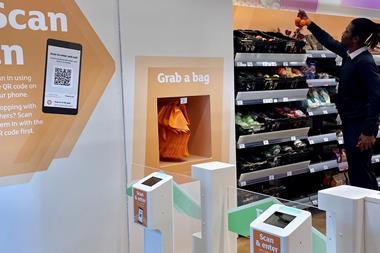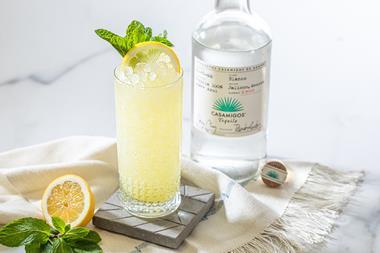Does Sainsbury’s new homeware range anchor a convincing non-food offer? Liz Hamson reports
Last week Sainsbury unveiled its new homeware range at its Chippenham store as it went into battle with John Lewis and Debenhams for a bigger share of the non-food market. Over the next two months, it plans to roll out the full range - which also includes a revamped clothing offer and expanded kids range - to 220 stores, and aspects of it across its whole estate.
The retailer, which currently controls a paltry 0.6% of the UK’s £108.6bn non-food market, is clearly banking heavily on leveraging its strong brand equity. It has increased the volume of its non-food own label brands from 10% to a 60%, in what MD Stuart Mitchell says is “one of the biggest own label launches in Europe”. But can it really compete with high street department stores and homeware outlets?
At the Chippenham store, the scale of the offer is certainly impressive. Now in one dedicated part of the store and discreetly branded under three banners: ‘For me’, mainly women’s clothing, ‘For kids’, toys and Adams childrenswear, and ‘For home’, homeware and home entertainment, non-food takes up some 13,000 sq ft of the 50,000 sq ft store. There are also 2,500 new homeware and home entertainment SKUs, with 300 more arriving in the next fortnight for Christmas and a further 1,300 mainly stationery lines next spring.
But there is a lot of ground to make up, admits Mitchell: “Non-food has clearly been a growth engine for Asda and Tesco and we have lost some customers who have been going there to get non-food.”
Former B&Q man Keith Evans, the new director of non-food brought in last year to spearhead the drive, adds: “Eleven million customers shop at Sainsbury but we had no health and beauty to speak of and our homeware was not developed. Sainsbury didn’t have the skills.”
It did not have the people either. So Karen Miller, a Terence Conran protégé and former M&S director, was drafted in as head of trends and designs as part of a major recruitment drive that also brought in personnel and ideas from Debenhams, Wedgwood, Pottery Barn in the US, Target, Next and Carrefour in France.
Neither Mitchell or Evans will disclose how much has been invested in the non-food drive but with the recruitment drive and fit-out costs it will add to a substantial figure.
In store, much of the new offer is being accommodated in additional space generated by the ongoing store “transformation” programme. In some stores it is being expanded into existing floorspace devoted to food, though not at the expense of the number of food lines, insists Evans.
The priority has been to produce high quality homeware at supermarket prices. Mitchell says: “We have been thinking about how we stretch our general merchandise as it was something our customers wanted. They wanted us to do it in a Sainsbury way, with ranges relevant to them and with care and attention to detail as with our own label food. They did not want us to be a me-too.”
Sainsbury has added 85 new suppliers to its fold from as far afield as China, India, Italy and Portugal. It has also adopted a three-tier pricing model intended to give shoppers a choice between basic “entry level” lines like the white china, standard and more premium items. Evans says: “I wanted stylish products at affordable prices - and they had to be high quality. You’ll see unbelievable prices with the quality up there with Heals or Habitat.”
Indeed, homeware specialists and department stores are seen as the main competition and there are clear similarities between the lines, Sainsbury’s new homeware range boasting basic white china crockery range starts at £1.50 - uncannily like Habitat’s.
That said, it is clearly trying to take on Asda’s George on price if not range. As part of the overhaul of its adult clothing range, it has slashed the number of Jeff & Co sub-brands from 12 to four - CMT, Navy Blue and Union and the Essentials - and increased the size of the Essentials range, bringing in cheaper lines like a £5 v-necked T-shirt to attract the value-conscious shopper.
There have been inevitable teething problems. Evans admits work needs to be done on the décor. There have also been replenishment problems with some popular lines despite changes made to the sourcing strategy - products are now sourced directly rather than through agents and brought in through its new non-food consolidation centre at Mendlesham and its Rugby depot.
And what do shoppers make of it? According to the cashiers the cushions and duvet covers have been flying off the shelves. Plumping up a bath towel, one middle aged female shopper coos: “Much better quality than the usual - and cheaper too.” Others, however, are less impressed. “Too expensive,” is one shopper’s verdict. “Why would I want to spend £30 on a mirror when I’m just coming in to do the weekly shop?”
The sheer range of both products and prices suggests that Sainsbury is not just targeting shoppers topping up their grocery shops - but also shoppers primarily after non-food items. It is a big gamble for a retailer with virtually no track record in non-food. Mitchell is, however, confident it is one worth taking: “We have not published a target but it’s a substantial pie and we can get a substantial bit of that pie without making any ridiculous claims.”
Needless to say, the City remains sceptical. “It needs to sort out its problems with its food offer first,” says one analyst, pouring scorn on Sainsbury’s claims that it has resolved its problems. Nick Coulter, retail analyst at Lehman Brothers, adds: “The opinion is that they have a premium offering at this point in time. Either they follow Asda [on EDLP] and retrench or they have to produce an offer worth paying for. Success hinges on convincing consumers that their food offering is attractive. The non-food could prove a bit of a distraction.”
Last week Sainsbury unveiled its new homeware range at its Chippenham store as it went into battle with John Lewis and Debenhams for a bigger share of the non-food market. Over the next two months, it plans to roll out the full range - which also includes a revamped clothing offer and expanded kids range - to 220 stores, and aspects of it across its whole estate.
The retailer, which currently controls a paltry 0.6% of the UK’s £108.6bn non-food market, is clearly banking heavily on leveraging its strong brand equity. It has increased the volume of its non-food own label brands from 10% to a 60%, in what MD Stuart Mitchell says is “one of the biggest own label launches in Europe”. But can it really compete with high street department stores and homeware outlets?
At the Chippenham store, the scale of the offer is certainly impressive. Now in one dedicated part of the store and discreetly branded under three banners: ‘For me’, mainly women’s clothing, ‘For kids’, toys and Adams childrenswear, and ‘For home’, homeware and home entertainment, non-food takes up some 13,000 sq ft of the 50,000 sq ft store. There are also 2,500 new homeware and home entertainment SKUs, with 300 more arriving in the next fortnight for Christmas and a further 1,300 mainly stationery lines next spring.
But there is a lot of ground to make up, admits Mitchell: “Non-food has clearly been a growth engine for Asda and Tesco and we have lost some customers who have been going there to get non-food.”
Former B&Q man Keith Evans, the new director of non-food brought in last year to spearhead the drive, adds: “Eleven million customers shop at Sainsbury but we had no health and beauty to speak of and our homeware was not developed. Sainsbury didn’t have the skills.”
It did not have the people either. So Karen Miller, a Terence Conran protégé and former M&S director, was drafted in as head of trends and designs as part of a major recruitment drive that also brought in personnel and ideas from Debenhams, Wedgwood, Pottery Barn in the US, Target, Next and Carrefour in France.
Neither Mitchell or Evans will disclose how much has been invested in the non-food drive but with the recruitment drive and fit-out costs it will add to a substantial figure.
In store, much of the new offer is being accommodated in additional space generated by the ongoing store “transformation” programme. In some stores it is being expanded into existing floorspace devoted to food, though not at the expense of the number of food lines, insists Evans.
The priority has been to produce high quality homeware at supermarket prices. Mitchell says: “We have been thinking about how we stretch our general merchandise as it was something our customers wanted. They wanted us to do it in a Sainsbury way, with ranges relevant to them and with care and attention to detail as with our own label food. They did not want us to be a me-too.”
Sainsbury has added 85 new suppliers to its fold from as far afield as China, India, Italy and Portugal. It has also adopted a three-tier pricing model intended to give shoppers a choice between basic “entry level” lines like the white china, standard and more premium items. Evans says: “I wanted stylish products at affordable prices - and they had to be high quality. You’ll see unbelievable prices with the quality up there with Heals or Habitat.”
Indeed, homeware specialists and department stores are seen as the main competition and there are clear similarities between the lines, Sainsbury’s new homeware range boasting basic white china crockery range starts at £1.50 - uncannily like Habitat’s.
That said, it is clearly trying to take on Asda’s George on price if not range. As part of the overhaul of its adult clothing range, it has slashed the number of Jeff & Co sub-brands from 12 to four - CMT, Navy Blue and Union and the Essentials - and increased the size of the Essentials range, bringing in cheaper lines like a £5 v-necked T-shirt to attract the value-conscious shopper.
There have been inevitable teething problems. Evans admits work needs to be done on the décor. There have also been replenishment problems with some popular lines despite changes made to the sourcing strategy - products are now sourced directly rather than through agents and brought in through its new non-food consolidation centre at Mendlesham and its Rugby depot.
And what do shoppers make of it? According to the cashiers the cushions and duvet covers have been flying off the shelves. Plumping up a bath towel, one middle aged female shopper coos: “Much better quality than the usual - and cheaper too.” Others, however, are less impressed. “Too expensive,” is one shopper’s verdict. “Why would I want to spend £30 on a mirror when I’m just coming in to do the weekly shop?”
The sheer range of both products and prices suggests that Sainsbury is not just targeting shoppers topping up their grocery shops - but also shoppers primarily after non-food items. It is a big gamble for a retailer with virtually no track record in non-food. Mitchell is, however, confident it is one worth taking: “We have not published a target but it’s a substantial pie and we can get a substantial bit of that pie without making any ridiculous claims.”
Needless to say, the City remains sceptical. “It needs to sort out its problems with its food offer first,” says one analyst, pouring scorn on Sainsbury’s claims that it has resolved its problems. Nick Coulter, retail analyst at Lehman Brothers, adds: “The opinion is that they have a premium offering at this point in time. Either they follow Asda [on EDLP] and retrench or they have to produce an offer worth paying for. Success hinges on convincing consumers that their food offering is attractive. The non-food could prove a bit of a distraction.”


















No comments yet